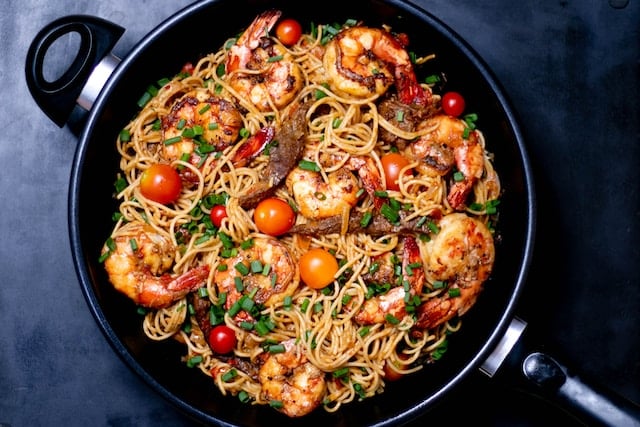Can You Prepare an Elegant French Tarte Flambée with Crème Fraîche and Lardons?

In the world of gastronomy, few cuisines match the elegance and complexity of French cooking. The intricate layering of flavors, combined with the importance of presentation, assures French dishes a place at the forefront of culinary arts. Among the most loved and versatile French recipes is the Tarte Flambée, a pizza-like delight from Alsace, adorned with crème fraîche, lardons, and onions. Let’s delve into the history and recipe of this unique French dish, so that you can prepare it right in your kitchen.
The Story of the Tarte Flambée
Before we embark on the culinary journey to create a Tarte Flambée, let’s take a moment to understand its origin. Hailing from the Alsace region of France, this dish was traditionally made by bakers to test the heat of their wood-fired ovens. The Tarte Flambée, or Flammkuchen as it’s known in German, translates to ‘flamed tart’. It’s a testament to the dish’s original cooking method, where it was quickly baked in the residual heat of a flaming oven.
Dans le meme genre : How to Perfect a Classic British Steak and Ale Pie with a Flaky Crust?
The Tarte Flambée is also referred to as the Alsatian Pizza. However, don’t be fooled. The Tarte Flambée is a unique dish, both in terms of preparation and ingredients. Unlike pizza, the dough of a Tarte Flambée is rolled out extremely thin, almost like a crepe, and then quickly cooked at a high temperature, giving it a crispy, delightful texture.
The Elegant Ingredients of Tarte Flambée
What sets Tarte Flambée apart are the classic toppings – crème fraîche, lardons (small strips or cubes of pork fat), and thinly sliced onions. These ingredients bring together a mix of creamy, salty, and sweet flavors that make the dish truly special.
Lire également : What’s the Best Method for Brewing a Rich Turkish Coffee at Home?
Crème fraîche is a dairy product native to France. It’s similar to sour cream but has a richer taste and a less tangy flavor. The creamy texture of crème fraîche complements the crunchy base of the Tarte Flambée perfectly.
Lardons, a type of bacon popular in French cuisine, adds a smoky flavor to the dish. These small strips of pork fat are salt-cured and occasionally smoked. When cooked, lardons release a significant amount of fat, which acts as a flavor enhancer.
Finally, thinly sliced onions, when baked, provide a delicate sweetness that balances the rich cream and salty lardons.
Creating the Perfect Tarte Flambée Dough
Making the dough for the Tarte Flambée may seem intimidating, but it’s a simple process. The dough doesn’t require yeast or leavening agents, making it quicker and easier to prepare than pizza dough.
The dough requires only four ingredients – flour, water, oil, and a pinch of salt. Begin by mixing the flour and salt, then gradually add water and oil. Knead until the dough becomes elastic and smooth. The key is to roll the dough as thin as possible without tearing it.
Allow the dough to rest for a bit before topping it. This rest period allows the gluten in the dough to relax, making it easier to roll out thinly.
Assembling and Cooking Your Tarte Flambée
Once the dough is prepared, it’s time to assemble your Tarte Flambée. Spread a thin layer of crème fraîche over the dough, leaving a small border around the edge. Then scatter the lardons and onions evenly over the cream.
The Tarte Flambée is traditionally cooked in a wood-fired oven. However, it can also be made in a modern home oven. The key to achieving the perfect Tarte Flambée is a high cooking temperature. Preheat your oven to the highest setting, usually around 250 degrees Celsius or even higher.
Bake the Tarte Flambée in the preheated oven for about 10-15 minutes, or until the edges are crispy and slightly charred. The high temperature ensures the dough cooks quickly while achieving a crisp, flaky texture.
Pairing Your Tarte Flambée
The beauty of Tarte Flambée lies not just in its flavors but also in how well it pairs with various beverages. An Alsatian white wine, such as a Riesling or a Gewürztraminer, complements the creaminess of the Tarte Flambée nicely. If you prefer beer, an Alsatian beer would also work well.
Your homemade Tarte Flambée makes a perfect appetizer or light main dish. Regardless of when you choose to serve it, we’re confident that this elegant French dish will impress your guests and take your home cooking to a new level. With a bit of practice, you’ll be able to whip up this delicious dish any time you desire. Enjoy the process of making Tarte Flambée, and most importantly, savor every bite.
Seasonality and Variations of Tarte Flambée
The beauty of Tarte Flambée lies not just in its classic recipe and elegant presentation but also in its versatility. Although it is widely enjoyed from January to December, the toppings can be altered to reflect the season’s freshest ingredients.
In the spring months of March and April, consider experimenting with fresh herbs like chives or parsley, and perhaps replace the onions with leeks. As the weather warms from June to August, try adding ripe tomatoes and basil for a summery twist. In the colder months of November and December, you could experiment with ingredients like roasted chestnuts or mushrooms for a heartier version.
Another interesting variation to the traditional recipe is to replace the crème fraîche with fromage blanc. This is a soft, creamy cheese with a slightly tangy flavor, similar to sour cream but less acidic. Some people also like to add a drizzle of olive oil for added richness. Regardless of the season or variation you choose, remember the essence of Tarte Flambée is in its thin, crunchy crust, creaminess from crème fraîche or fromage blanc, and savory punch from the lardons.
Wine Pairings for Tarte Flambée
Pairing wine with Tarte Flambée can elevate the entire dining experience. Given the dish’s origins in Alsace, it’s no surprise that Alsatian wines make an excellent match.
White wines from this region are particularly well-suited to balance the rich, creamy, and savory flavors of Tarte Flambée. A traditional Alsatian Riesling, for instance, offers a refreshing acidity that can cut through the creaminess of the crème fraîche and the richness of the lardons. Its mineral notes and delicate fruitiness also harmonize with the sweet, caramelized onions.
If you prefer a more aromatic wine, consider an Alsatian Gewürztraminer. This white wine is known for its lush tropical fruit flavors and hints of spice, which make a fascinating contrast to the savory elements of Tarte Flambée.
Conclusion
Creating an elegant French Tarte Flambée with crème fraîche and lardons is an engaging culinary adventure, but it’s not beyond reach. Even if you’re a novice in the kitchen, this guide gives you all the techniques and tips you’ll need to successfully prepare this classic Alsatian dish.
From the simplicity of the dough to the harmony of ingredients like crème fraîche, lardons, and onions, to the potential for seasonal variations, and finally, to the joy of pairing it with a well-suited white wine—every step of making Tarte Flambée is a celebration of French cuisine.
So, whether you’re planning a dinner party in September or October, or just a quiet evening in July or June, don’t hesitate to try your hand at this dish. Your effort will be rewarded with a delicious, satisfying meal that’s bound to impress. The artistry and elegance of Tarte Flambée, after all, is a testament to the enduring charm of French cooking.
